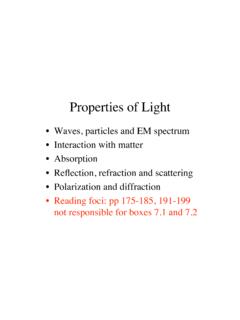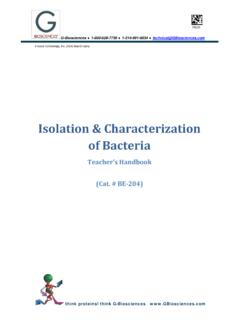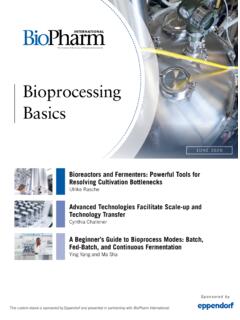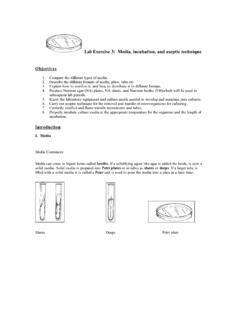Transcription of LAB 4. Cultivation of Bacteria - University of Maryland ...
1 lab 4 . Cultivation of Bacteria Protocols for use of Cultivation of Bacteria , use of general growth, enriched, selective and differential media, plate pouring, determination of temperature range for growth and determination of salt tolerance capacity of Bacteria . INTRODUCTION. In nature, Bacteria exist as mixed populations. In the laboratory these populations must be separated so that characteristics of individual species may be observed. A number of basic techniques are used in microbiology with this end in mind. First, microorganisms must be removed from natural environments and cultured in the laboratory. This requires artificial media and surfaces on which Bacteria may grow.
2 This also requires knowledge of nutritional requirements and environmental requirements (such as temperature of incubation and the requirement of oxygen). Second, Bacteria of interest must be separated from all other Bacteria in the environmental sample. This requires separation techniques that allow isolation of a pure culture of one type of Bacteria . Third, once a pure culture is achieved, no contaminating Bacteria can be introduced from the environment. This requires that all media and lab supplies be sterile (that is contain no Bacteria that may contaminate the culture of interest). Fourth, techniques are needed that facilitate working with pure cultures.
3 This requires aseptic technique and techniques of storage for pure cultures. When microbial ecologists seek to isolate new Bacteria from the environment, they must experiment with many nutrients and growth conditions to culture the newly isolated Bacteria in the lab. It is often very difficult to replicate bacterial growth conditions in the lab. It is estimated that only of all Bacteria have been successfully cultured. A. Use of Media: Types of media. The fundamental function of bacterial media is to provide nutrients for the growth of microbes in the lab. Media designed for growth are defined below. General Growth media support the growth of a broad range of organisms.
4 General growth media usually have complex constituents. Examples of General Growth media that are also complex include: Trypticase-soy and Nutrient media. Media may be designed to support the growth of one particular organism. Constituents of such media are generally defined and the media is referred to as Chemically Defined media. An example is the Glucose Minimal Salts Broth designed to support growth of (see Figure 1). Enriched media is designed to support the growth of organisms with unusual growth requirements. Such organisms are referred to as fastidious . Special nutrients are added to a general growth media to support the needs of organisms with demanding nutritional requirements.
5 The supplements added will vary dependent upon the particular requirements of the fastidious organism An example of an enriched medium is T-soy medium supplemented with sheep blood (when agar is added to this medium it is commonly called blood agar ). Because the task of isolating a given bacterial species from a mixture can often be simplified by taking advantage of a particular nutritional requirement of a given species, constituents of media can be varied to select for, or differentiate among bacterial types. Media designed for selection and differentiation are described below. Selective media will permit the growth of one type of Bacteria while preventing the growth of other types.
6 This will facilitate the isolation of a desired species. MacConkey's medium is selective. It contains bile salts and crystal violet, these will inhibit the growth of Gram-positive organisms. Other examples include phenylethyl alcohol agar, which inhibits or slows the growth of Gram-negative organisms, and mannitol salt agar which inhibits the growth of salt intolerant organisms. Differential media will allow visual differentiation between two or more species of Bacteria . Examples include blood agar, MacConkey's medium and Mannitol Salt agar. T Colonies growing on blood agar are differentiated by hemolysis patterns (greening - alpha hemolysis, clearing - beta hemolysis and no hemolysis - gamma).
7 Figure T Using MacConkey's medium, lactose fermenting and lactose non-fermenting Bacteria can be distinguished. Organisms that are able to ferment lactose will produce an acid end-product that causes a change in the pH of the surrounding media. A pH indicator (neutral red), is present in the media and changes from yellow to red in an acidic environment. Lactose fermenting Bacteria growing on MacConkey's media will appear pink whereas non-lactose fermenters will be white. Figure T Mannitol salt agar allows discrimination among salt tolerant organisms. Those that ferment mannitol will produce acid turning the pH indicator (phenol red) to a yellow color. Those that cannot ferment mannitol will leave the media the red color of phenol red at nuetral pH.
8 Figure Solid vs liquid media Organisms can be grown in liquid media (broth) or on solid media. For example, Nutrient media is referred to as Nutrient Broth when in the liquid form, and Nutrient Agar when in the solid form. Agar, a galactan obtained from marine algae is used as the hardening agent in solid media. Broth, with added agar powder, is heated to 121o C in an autoclave, dissolving the agar and sterilizing the medium. The molten medium may be poured into plates or tubes. The agar-media will remain liquid at temperatures above 45o C. Below 45o C the agar will harden, and supply a solid surface for the growth of Bacteria . Agar plates and slants may be inoculated after they have solidified.
9 To avoid any condensation-droplets from falling onto agar surfaces and smearing the inoculum, agar plates are inverted during incubation. Figure 1. Media constituents Nutrient Agar: Example of a complex, general growth media Constituent Amount Peptone Beef extract g Sodium Chloride g Agar g Water 1 1iter Glucose Minimal Salts Broth: Example of chemically defined medium designed for the growth of Constituent Amount Glucose g Ammonium phosphate monobasic g Sodium chloride g Magnesium sulfate g Potassium phosphate, dibasic Water 1 liter Reference: Tortura, Funke, Case, 1998, Microbiology, An Introduction, 6th edition, Addison Wesly Longman Inc. To study Bacteria from an environmental sample or a mixed culture it is necessary to isolate a pure culture of each bacterium of interest.
10 Using differing growth conditions and a variety of media, one can begin to separate Bacteria , but, generally, methods to physically separate Bacteria are also needed. B. Use of Physical Separation Procedures: i Streak Plate technique As we have seen in previous labs, single colonies may be achieved by using the streak plate technique . Additional methods used to physically separate Bacteria include;. dilution in liquid, the pour plate (where diluted cultures are poured onto a solid medium spreading over it's surface) and the spread plate (where diluted cultures are spread onto a solid medium and thus distributed over the medium surface). These additional methods will be described later in this manual.











